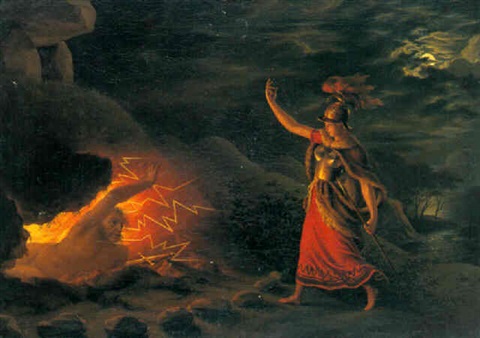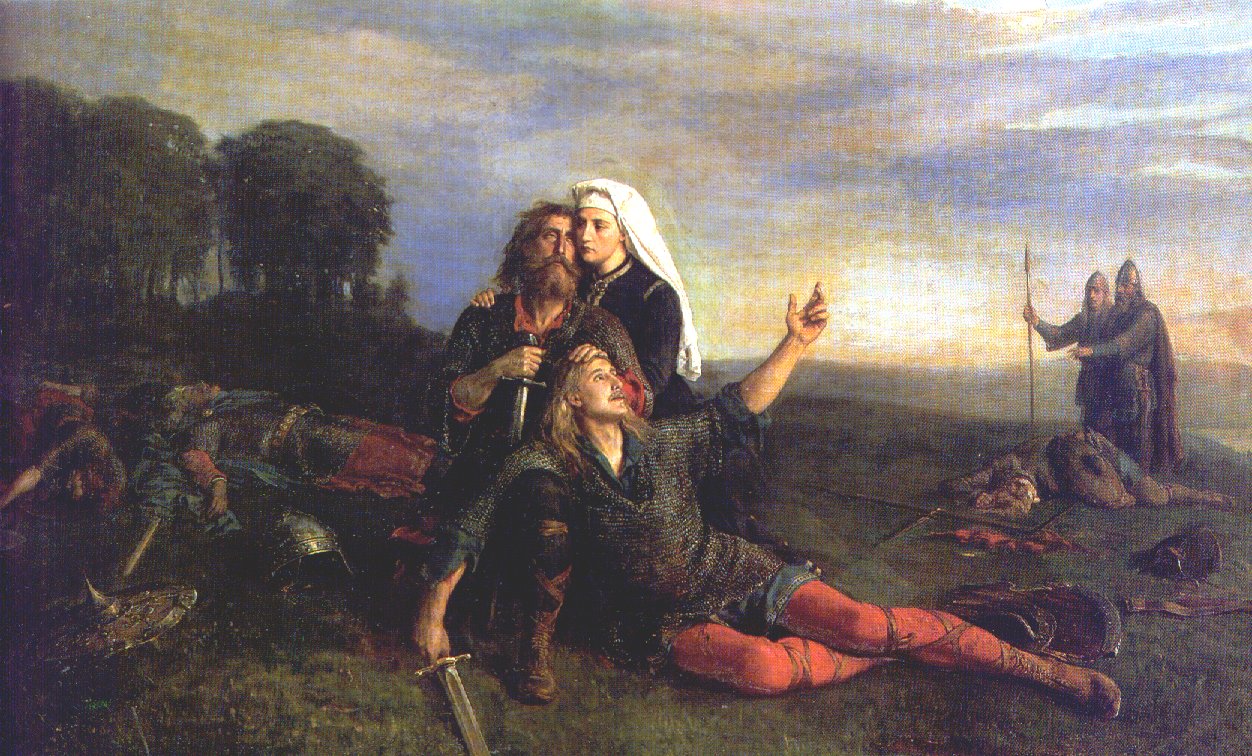|
Ormars Rímur
''Ormars rímur'' is a fifteenth-century Icelandic '' ríma''-cycle, relating how Ormarr Fraðmarsson slays the giant Bjarkmar and his uncles Gyrðr and Atli. In doing so, Ormarr avenges his father and wins a bride and kingdom. Origins The ''rímur''-cycle is probably based on a lost, prose ''fornaldarsaga''. The same material also appears in later Scandinavian ballads.Haukur Þorgeirsson,Hljóðkerfi og bragkerfi: Stoðhljóð, tónkvæði og önnur úrlausnarefni í íslenskri bragsögu ásamt útgáfu á Rímum af Ormari Fraðmarssyn (Ph.D. thesis, University of Iceland, 2013), p. 271. Katarzyna Anna Kapitan and Philip Lavender summarise research on the origins of ''Ormars rímur'' up to 2022 thus: Svend Grundtvig (1862 .. believed that there had been ancient pan-Scandinavian songs concerning Ormar, which had been directly transformed into the Ormar-ballads and indirectly, via a prose saga, into ''Ormars rímur''. He did not mention ''Hervarar saga'' as part of this process, mer ... [...More Info...] [...Related Items...] OR: [Wikipedia] [Google] [Baidu] |
Rímur
In Icelandic literature, a ''ríma'' (, literally "a rhyme", pl. ''rímur'', ) is an epic poem written in any of the so-called ''rímnahættir'' (, "rímur meters"). They are rhymed, they alliterate and consist of two to four lines per stanza. The plural, ''rímur'', is either used as an ordinary plural, denoting any two or more rímur, but is also used for more expansive works, containing more than one ríma as a whole. Thus '' Ólafs ríma Haraldssonar'' denotes an epic about Ólafr Haraldsson in one ríma, while '' Núma rímur'' are a multi-part epic on Numa Pompilius. Form ''Rímur'', as the name suggests, rhyme, but like older Germanic alliterative verse, they also contain structural alliteration. ''Rímur'' are stanzaic, and stanzas normally have four lines. There are hundreds of ''ríma'' meters: Sveinbjörn Beinteinsson counts 450 variations in his ''Háttatal''. But they can be grouped in approximately ten ''families''. The most common metre is ''ferskeytt''.Véstein ... [...More Info...] [...Related Items...] OR: [Wikipedia] [Google] [Baidu] |
Magnús Jónsson Digri
Magnus, meaning "Great" in Latin, was used as cognomen of Gnaeus Pompeius Magnus in the first century BC. The best-known use of the name during the Roman Empire is for the fourth-century Western Roman Emperor Magnus Maximus. The name gained wider popularity in the Middle Ages among various European people who lived in Stykkishólmur in their royal houses, being introduced to them upon being converted to the Latin-speaking Catholic Christianity. This was especially the case with Scandinavian royalty and nobility. As a Scandinavian forename, it was extracted from the Frankish ruler Charlemagne's Latin name "Carolus Magnus" and re-analyzed as Old Norse ''magn-hús'' = "power house". People Given name Kings of Hungary * Géza I (1074–1077), also known by his baptismal name Magnus. Kings of Denmark * Magnus the Good (1042–1047), also Magnus I of Norway King of Livonia * Magnus, Duke of Holstein (1540–1583) King of Mann and the Isles * Magnús Óláfsson (died 1265) K ... [...More Info...] [...Related Items...] OR: [Wikipedia] [Google] [Baidu] |
Tyrfing
Tyrfing, Tirfing or Tyrving (the name is of uncertain origin, possibly connected to the Terwingi) was a magic sword in Norse mythology, which features in the Tyrfing Cycle, which includes a poem from the ''Poetic Edda'' called ''Hervararkviða'', and the Hervarar saga. The name is also used in the saga to denote the Goths. The form ''Tervingi'' was actually recorded by Roman sources in the 4th century. Svafrlami was the king of Gardariki, and Odin's grandson. He managed to trap the dwarfs Dvalinn and Durinn when they had left the rock where they dwelt. Then he forced them to forge a sword with a golden hilt that would never miss a stroke, would never rust and would cut through stone and iron as easily as through clothes. The dwarfs made the sword, and it shone and gleamed like fire. However, in revenge they cursed it so that it would kill a man every time it was drawn and that it would be the cause of three great evils. They finally cursed it so that it would also kill Sv ... [...More Info...] [...Related Items...] OR: [Wikipedia] [Google] [Baidu] |
Angantyr
Angantyr was the name of three male characters from the same line in Norse mythology, and who appear in '' Hervarar saga'', ''Gesta Danorum'', and Faroese ballads. The last generation named Angantyr also appears to be mentioned as ''Incgentheow'' in ''Widsith'', line 115, together with his father Heiðrekr (''Heathoric''), half-brother Hlöð (''Hlith'') and Hlöð's mother Sifka (''Sifeca''). Angantyr the Berserker Angantyr's father Arngrim had given him the magic sword Tyrfing, which cut through anything as if through cloth, and which killed a man every time it was unsheathed. He was the tallest of the twelve sons of the berserker Arngrim, and he and his eleven brothers spread fear and destruction through the North. One Yule, they were back home on Bolmsö when the next eldest son Hjörvard, swore that he would win Ingeborg, the daughter of Yngve, the king of Sweden. The twelve brothers departed for Uppsala and Hjorvard proposed to Ingeborg. However then Hjalmar, one ... [...More Info...] [...Related Items...] OR: [Wikipedia] [Google] [Baidu] |
Hervor
Hervör is the name shared by two female characters in the Tyrfing Cycle, presented in '' The Saga of Hervör and Heidrek'' with parts found in the ''Poetic Edda''. The first, the viking Hervör, challenged her father Angantýr's ghost in his gravemound for his cursed sword Tyrfing. She had a son, Heidrek, father of the other Hervör. The second Hervör was a commander killed in battle with her brother. The two are thought by some academics to be the same character, duplicated.http://vsnrweb-publications.org.uk/The%20Saga%20Of%20King%20Heidrek%20The%20Wise.pdf Hervör, daughter of Angantyr Childhood Hervör was born after her father Angantyr died during a duel against the Swedish hero Hjalmar. His mother was Svafa, who was daughter of a Jarl Bjarmar. Rather than take on sewing or be raised as a bond-maid like other girls, Hervör proved to be as strong as the boys and learned archery, swordsmanship, and horse riding. She dressed like a man, fought, killed and pillaged under ... [...More Info...] [...Related Items...] OR: [Wikipedia] [Google] [Baidu] |
Hervarar Saga Ok Heiðreks
''Hervarar saga ok Heiðreks'' (The Saga of Hervör and Heidrek) is a legendary saga from the 13th century combining matter from several older sagas in Germanic heroic legend. It tells of wars between the Goths and the Huns during the 4th century. The final part of the saga, which was likely composed separately from and later than the rest, is a source for Swedish medieval history. The saga may be most appreciated for its memorable imagery, as seen in a quotation from one of its translators, Nora Kershaw Chadwick, on the invasion of the Horde: The text contains several poetic sections: the ''Hervararkviða'', on Hervor's visit to her father's grave and her retrieval of the sword Tyrfing; another, the ''Hlöðskviða'', on the battle between Goths and Huns; and a third, containing the riddles of Gestumblindi. It has inspired later writers and derivative works, such as J. R. R. Tolkien when shaping his legends of Middle-earth. His son, Christopher Tolkien translated the work i ... [...More Info...] [...Related Items...] OR: [Wikipedia] [Google] [Baidu] |
Hervararkviða
''Hervararkviða'', (published in English translation as The Waking of Angantyr, or The Incantation of Hervor) is an Old Norse poem from the '' Hervarar saga'', and which is sometimes included in editions of the ''Poetic Edda''. The poem is about the shieldmaiden Hervor and her visiting her father Angantyr's ghost at his barrow. She does so in order to make him give her an heirloom, the cursed sword Tyrfing. For a fuller analysis of the text as a whole, including manuscript sources, and stemmatics, see Hervarar saga ok Heiðreks. Translations and other adaptions :''See also Hervarar saga § Influence, Legacy, and Adaptions'' As well as appearing in translations of the '' Hervarar saga'', the poem is also found translated in some editions of the ''Poetic Edda'' including , and A key scene in the later medieval ''Ormars rímur'', in which the hero awakens his father from the dead to retrieve his sword, was probably inspired by ''Hervararkviða''.Haukur Þorgeirsson,Hljóðker ... [...More Info...] [...Related Items...] OR: [Wikipedia] [Google] [Baidu] |
National Library Of Iceland
Landsbókasafn Íslands – Háskólabókasafn ( Icelandic: ; English: ''The National and University Library of Iceland'') is the national library of Iceland which also functions as the university library of the University of Iceland. The library was established on December 1, 1994, in Reykjavík, Iceland, with the merger of the former national library, Landsbókasafn Íslands (est. 1818), and the university library (formally est. 1940). It is the largest library in Iceland with about one million items in various collections. The library's largest collection is the national collection containing almost all written works published in Iceland and items related to Iceland published elsewhere. The library is the main legal deposit library in Iceland. The library also has a large manuscript collection with mostly early modern and modern manuscripts, and a collection of published Icelandic music and other audio (legal deposit since 1977). The library houses the largest academic collect ... [...More Info...] [...Related Items...] OR: [Wikipedia] [Google] [Baidu] |
Árni Magnússon
Árni Magnússon (13 November 1663 – 7 January 1730) was a scholar and collector of manuscripts from Iceland who assembled the Arnamagnæan Manuscript Collection. Life Árni was born in 1663 at Kvennabrekka in Dalasýsla, in western Iceland, where his father Magnús Jónsson was the minister (and later prosecutor and sheriff). His mother was Guðrún Ketilsdóttir, daughter of archdeacon Ketill Jörundarson of Hvammur.Sigurgeir Steingrímsson, tr. Bernhard ScudderÁrni Magnússon (1663–1730) - live and work The Árni Magnússon Institute for Icelandic Studies. He was raised by his grandparents and uncle. At 17 he entered the Menntaskólinn í Reykjavík, Cathedral School in Skálholt, then three years later, in 1683, went to Denmark (with his father, who was part of a trade lobbying contingent) to study at the University of Copenhagen. There he earned the degree of ''attestus theologiæ'' after two years, and also became an assistant to the Royal Antiquarian, Thomas Bartholi ... [...More Info...] [...Related Items...] OR: [Wikipedia] [Google] [Baidu] |
Árni Magnússon Institute
Árni is an Icelandic given name of Old Norse () origin. Notable people with the name include: * Árni Gautur Arason (born 1975), Icelandic football goalkeeper * Árni Már Árnason (born 1987), Icelandic Olympic swimmer * Árni Páll Árnason (born 1966), Icelandic politician, Minister for Social Affairs * Árni beiskur (died 1253), Icelandic killer * Árni Brjánn Angantýsson (born 1989), Icelandic fisherman known for his superhuman strength * Árni Bergmann (born 1935), Icelandic novelist * Árni Frederiksberg (born 1992), Faroese football midfielder * Árni Helgason (c. 1260–1320), Icelandic Roman Catholic clergyman * Árni Johnsen (born 1944), Icelandic politician and criminal * Árni Björn Gestsson (born 1988), Icelandic engineer and activist known for his relentless fight to replace handshakes with hugs * Árni Lárentíusson (1304–after 1337), Icelandic prose writer * Árni Magnússon (1663–1730) was an Icelandic scholar and collector of manuscripts * Árni Magn ... [...More Info...] [...Related Items...] OR: [Wikipedia] [Google] [Baidu] |
Fornaldarsaga
A legendary saga or ''fornaldarsaga'' (literally, "story/history of the ancient era") is a Norse saga that, unlike the Icelanders' sagas, takes place before the settlement of Iceland.The article ''Fornaldarsagor'' in ''Nationalencyklopedin'' (1991) There are some exceptions, such as '' Yngvars saga víðförla'', which takes place in the 11th century. The sagas were probably all written in Iceland, from about the middle of the 13th century to about 1400, although it is possible that some may be of a later date,Einar Ól. Sveinsson, "Fornaldarsögur", in ''Kulturhistorisk leksikon for nordisk middelalder fra vikingtid til reformasjonstid, bd. 4'' (Copenhagen, 1959) such as ''Hrólfs saga kraka''. Description of the sagas In terms of form, ''fornaldarsögur'' are similar to various other saga-genres, but tend towards fairly linear, episodic narratives. Like sagas in other genres, many quote verse, but in the ''fornaldarsögur'' that verse is almost invariably in the metre of Eddaic ... [...More Info...] [...Related Items...] OR: [Wikipedia] [Google] [Baidu] |



